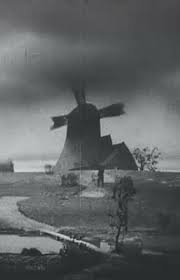
A miller (Albert Steinruck) lives in a mill near the border of two countries. He lives a quiet life with his wife (Fay Wall) and his children, two boys, Michael (Imre Raday) and John (William Dieterle), John’s wife (Camilla von Hollay) and the miller’s daughter Magda (Brigitte Helm). There have been whispers of war between his country and the country on the other side of the border. One day a journeyman (Erwin Faber) comes to the mill looking for a job. The miller takes him in.
Soon a vender (Max Schreck) comes by. The vender is actually a spy and the journeyman is a traitor from the country just on the other side of the border. The spy pays the traitor to set up a phone line in case war breaks out between the two countries. The journeyman doesn’t like being a traitor but he likes the money. The journeyman falls in love with Magda but she doesn’t feel the same way.
The village near the mill is having a celebration for the mill’s 700th anniversary. Everyone goes to the celebration. There is a carnival, a side show, food, music and dancing. During the celebration riders come into town bringing news that war has been declared. Eventually the enemy storms over the border and the defending army retreats. The enemy captain (Victor Janson) and his men take over the mill. The miller’s son Michael defies the captain, is arrested and sentenced to death. Magda tries to intercede for her brother. The captain turns his leering eyes to Magda. Magda is disgusted by the captain and runs away.
The enemy lieutenant (Jean Bradin) is sympathetic to Magda’s plight. He offers, with no strings attached, to save Michael. The captain is still after her and so is the journeyman spy. Magda is pretty much disgusted with all men at this point and the mill is being shelled by their own country since the enemy has taken it over. Things are not looking good for the miller and his family.
“At the Edge of the World” AKA “Am Rande der Welt” was released in 1927 and was directed by Karl Grune. It is a German silent anti-war movie. There are six acts to the film.
Director Grune completed his film and the production company UFA studios presented it to the German film censors. After that UFA was taken over by conservative industrialist Alfred Hugenberg. Hugenberg made some, what Grune called, drastic cuts in the film which pissed off Grune. Grune protested the cuts and claimed that UFA had made opinionated and artistic cuts. Grune sued to have his name taken off the film.
As a movie to watch it’s OK. The main draw for it is that it is beautifully filmed. There are some wonderful German expressionistic aspects to it. The cinematographer was done by Fritz Arno Wagner and his camera work is fantastic. He worked with Murnau. As far as showing some of the aspects of war in a stylized and esoteric manner it is rather powerful.
It is an obscure film and as far as I know it’s never been released on video. At least in the U.S., but it is available as an “on request” DVD-R in places. The film is on the Archives but only in a shortened format that only runs about 64 minutes. It does have English intertitles but because so much it cut out you lose a lot of the symbolism and expressionistic flavor of the film. Plus the one on the archive is in really crappy shape. You can see it in its full 104 minutes but only on filmportal.de but it has German intertitles. That’s what Filmportal does; it is an internet platform for German films. Even though the intertitles are in German it’s still worth seeing it whole since that is where all the artistic flare is.
Update: I finally found the original German film with German intertitles.
Shortened version
German version

